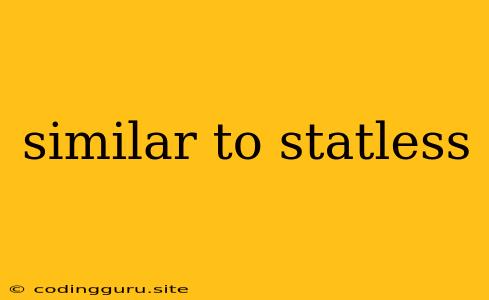What Does "Similar to Stateless" Mean?
When we talk about something being "similar to stateless," we're stepping into the realm of computer science, particularly in the world of web development and application design. To understand this concept, we need to first grasp the core idea of "statelessness."
Statelessness Explained
In simple terms, a stateless system is one that doesn't remember past interactions. Think of it like a vending machine. You put in money, choose your snack, and get what you ordered. The vending machine doesn't "remember" your previous purchases; each transaction is independent.
Key characteristics of a stateless system:
- No persistent data storage: Each request is treated as a fresh start.
- Simplified logic: The system only needs to process the current request, without needing to refer to past interactions.
- Scalability: Because each request is isolated, you can easily add more servers to handle increasing traffic.
Why "Similar to Stateless" Matters
Why do we talk about systems being "similar to stateless" instead of simply "stateless"? It's because true statelessness can sometimes be impractical or even impossible. Certain situations might require some degree of state management for functionality. Here's why:
- User experience: Imagine browsing an online store. You add items to your cart. A truly stateless system would require you to re-add those items each time you navigate to a different page. This is a terrible user experience.
- Session management: Logins, user profiles, and other information need to be maintained across multiple interactions.
"Similar to Stateless" in Action:
So, what does it mean to be "similar to stateless"? It means striving for the benefits of statelessness while accommodating the necessary state management. This is often achieved through various techniques:
- Session Management: Using cookies, tokens, or similar mechanisms to maintain user data for a limited time.
- Caching: Storing frequently accessed data in a temporary location to reduce the need for repeated database queries.
- Microservices: Breaking down a large application into smaller, independent services that can operate with minimal state.
Example:
Consider a website that allows users to create and edit their profiles. The profile editing process itself could be designed to be "similar to stateless." The user's profile data is stored in a database, but the actual editing process might involve:
- Retrieving the profile data: This initial retrieval is stateful, as it requires accessing the database.
- Editing the data in a temporary buffer: The edits happen in memory, mimicking a stateless approach.
- Saving the edited data: The final step of saving the updated profile data is again stateful, as it involves updating the database.
Benefits of the "Similar to Stateless" Approach:
By aiming for a system that's "similar to stateless," you can reap many of the advantages of statelessness while maintaining the functionality required for a user-friendly application:
- Improved scalability: Even with some state management, the system can still scale efficiently.
- Simplified testing: Since each request is largely independent, testing becomes more manageable.
- Enhanced security: With less reliance on persistent state, you can mitigate risks like data breaches and vulnerabilities.
Considerations for Designing "Similar to Stateless" Systems:
- Identify the areas where true statelessness is possible: Focus on making those parts as stateless as feasible.
- Manage state carefully: Use techniques like caching, session management, or microservices to handle the necessary state management.
- Keep state duration minimal: Minimize the time data is stored in memory or temporary storage.
- Embrace immutability: Consider using immutable data structures for managing state, where data is never modified directly, only replaced with new versions.
Conclusion:
The concept of being "similar to stateless" is a valuable approach in modern application development. It enables you to harness the advantages of stateless architectures while accommodating the real-world complexities of managing user data and maintaining a positive user experience. By carefully designing and implementing this approach, you can build systems that are more scalable, secure, and maintainable in the long run.
